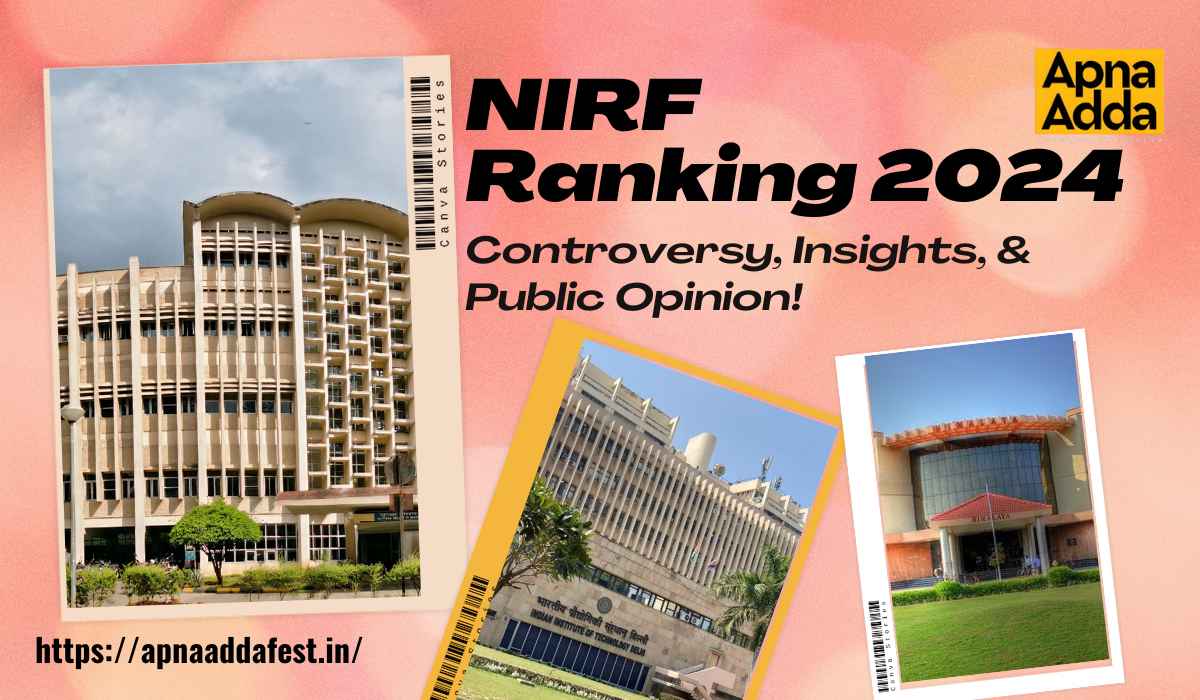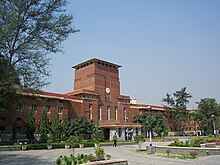NIRF Ranking 2024: Controversy, Insights, and Public Opinion

The National Institute Ranking Framework (NIRF) has released it's ranking list for the year 2024 on August 12, 2024. The list that was topped by the Indian Institute of Technology-Madras (IIT-Madras) has been all over the news and is being criticized by the common people for it's political alignment.
Amidst all the chaos, the heyday that is observed is worth noting. Every institution in the top-100 list and more precisely, every institution that is in the top-10 category, has brought an emotional battle between satisfaction and dismay.
Table Of Contents:
What is NIRF?
NIRF stands for National Institute Ranking Framework, which is the Ministry of Education's cerebral framework and is a methodology dealing with the rank ups and downs of any institution all across the country.
It is the second hand of the education system of the country, as it not only helps in shaping the nation but also provides a sheer glimpse of the nervous system of educational institutions and allows students to decide which institution is apt for them.
The key objective of the introduction of a system like this was to promote promote excellence in the academic front. The methodology derives from the broad knowledge and overall suggestions reached by a Core Committee, which was established by MHRD, in order to determine the general parameters for rating different universities and institutes.
Thus, to broaden our understanding of the same, it is important to establish an understanding of the evaluation or rating criteria.
Ranking Criteria
Conventionality and Westernization come into play when the NIRF ranking is talked about. With a critically vast nation with diversity and versatility at its center, it became important for the Ministry to decide error-less parameters to evaluate the institutions without depriving them of equal opportunity.
Let's dive deeper into these parameters to gain a better understanding of the technicality of the academic tool, NIRF.
• Parameter 1: Teaching, Learning, and Resources:
The core activities of any institution, including faculty qualifications, student-faculty ratio, resources for teaching, and others, fall under this category.
• Parameter 2: Research and Professional Practices:
Researchers and research that contribute to the development of the nation in all possible senses fall under this parameter. Evaluation of research outcomes, quality, publication, patents, and collaborative projects are the core criteria.
• Parameter 3: Graduation Outcomes:
Placements, internships, apprenticeships, and any other employment that any institution offers after graduation completion fall under this parameter.
• Parameter 4: Outreach and Inclusivity:
This parameter mostly deals with evaluating an institution's societal outreach, including community engagement, student-oriented drives, and any diversity-oriented measures.
• Parameter 5: Perception:
What you receive is how you act! What every person involved with the institution perceives in any other manner about the institution structures the overall ranking of the institution.
Methodology :
There is a systematic way of getting evaluated through the process, which includes:
1) Data Collection: This includes collection of data from resources available. Institutions submit a defined collection of all their activities, including research, academic, and infrastructure-related information.
2) Expert Committees: A systemic committee of policymakers, academicians, researchers, and many more sits to process the given data by the institutions and review the same to ensure a standardized and objectified evaluation.
3) Scoring and Weightage: The weight of a parameter is solely based on its significance in determining the overall rank and the final scores with simple addition result in determining it's overall category.
Top-10 Ranking 2024
Educational multiverses, including engineering colleges, universities, architectural colleges, dental schools, medical schools and many more, take part in the race of NIRF rankings every year to get the award of being at the top of the list. This list thus formed becomes the Magna Carta of the institutions nationwide.
Like every year, this year too the NIRF ranking has turned out to be amusingly a tough-fought-battle-result.



The ranking that follows stands as:
• Position 1 : Indian Institute of Technology Madras; Tamil Nadu - 86.42 points
• Position 2 : Indian Institute of Science, Bengaluru; Karnataka 83.28 points
• Position 3 : Indian Institute of Technology Bombay; Maharashtra - 81.37 points
• Position 4 : Indian Institute of Technology Delhi; Delhi - 80.31 points
• Position 5 : Indian Institute of Technology Kanpur; Uttar Pradesh - 77.56 points
• Position 6 : Indian Institute of Technology Kharagpur; West Bengal - 74.77 points
• Position 7 : All India Institute of Medical Sciences Delhi; Delhi - 74.27 points
• Position 8 : Indian Institute of Technology Roorkee; Uttarakhand - 71.52 points
• Position 9 : Indian Institute of Technology Guwahati; Assam - 69.04 points
• Position 10 : Jawaharlal Nehru University; Delhi - 68.53 points
Banaras Hindu University stands just below Jawaharlal Nehru University at position 11 with 67.56 points.
Delhi University Is Where?
Delhi University, a dream come true for most of the students out there, has always been in the news for its position. Its also shocking to note that, like other years, in spite of its extensively wide and broad study-activity-oriented curriculum structure, the university is positioned to be 15th in the overall list and in the specific university list, it stands at 6th. Although it is a leap up from last year's 11th position, the rank allocated still stands disappointing.
An alarming and dissatisfying trend among youngsters is seen in the 2024 NIRF ranking. The very importance of the NIRF ranking is to allow students to choose a better university according to their caliber, capability, and diligence. The ranking in no manner is to provide a wrong glimpse of any university to any student. And for better understanding, every specific list should be studied; an overall list usually contains the technical universities and colleges.
Non-Tech Colleges: Worth It!
Each and every one of us has somewhere encountered a very peculiar question in life: Why not science? Was it not a very pungent-smelling question that ruined the decorum of our minds? Indeed, it was!
The question is strictly a disturbing one because our minds are somewhat aware of the facts of how critically difficult it is to satisfy our needs as non-tech students, and the NIRF ranking surely approves of the same.
Its important to note that in a nation like India, where the sole motive of people is to establish themselves, studying the humanities in all respects becomes difficult. Its also seen that people of science backgrounds turning towards the humanities are put to question! The question is, why? The answer is rankings like these.
It is thus the need of the hour to promote subjects of the humanities, including arts and social sciences, to create golden opportunities for students and thus, in the rat race, universities should find their ways not only to outcast any other technical university but to establish their core existence.
Public View
Let's find out what the public view is on the NIRF ranking 2024 and whether consent or dissent is a subject to quote.
• Person 1 : "NIRF takes the data from the college. They don't visit."
• Person 2 : "LPU and Amity are under 50. Now you can judge the quality of rankings. 😂"
• Person 3 : "I saw it just an hour ago. It's nuts. I'm from Punjab and I know where Chandigarh University stands; it definitely shouldn't be on the list, and Amity?? Really?"
• Person 4 : "From my understanding, do not go by the rank given to an institution. Instead, try to see whether the institution you are searching for is ranked or not."
• Person 5 : "The rankings are correct, but they are not meant for students to decide what college to attend. Do NOT pick your college based on NIRF ranking; in fact, completely ignore them."
Penning or quoting every argument is impossible but Reddit shares many more argumentative statements that tend to offer a wider view of how distinct and superficial the NIRF ranking is and to say in a nutshell, CANDIDATES BE NOT choose THEIR COLLEGES BASED ON THIS, which would stand solely apt.
Conclusion
Since NIRF ranking is based on various factors, for a child to make a decision, all these factors usually stand irrelevant, so choose your destination based on what you call analysis and not merely on reports.
For more such interesting and exciting updates about your college and upcoming fests, stay tuned to Apna Adda.

